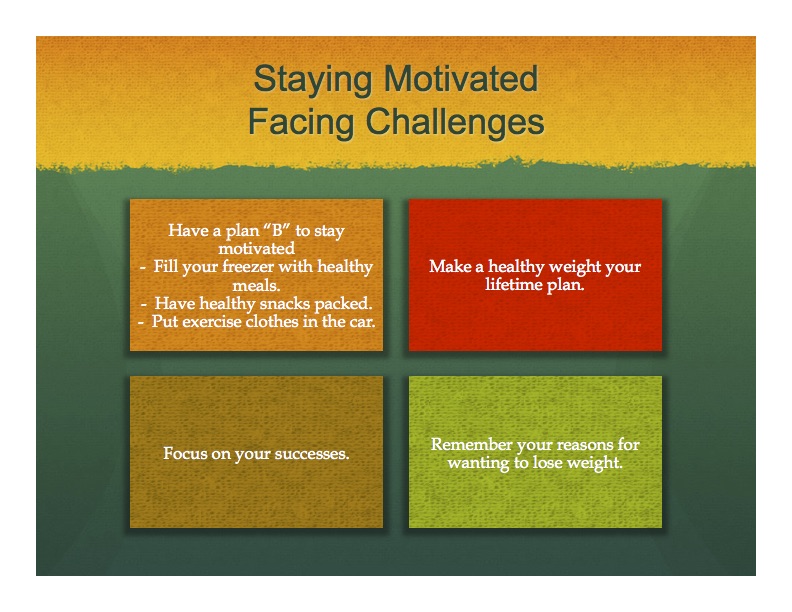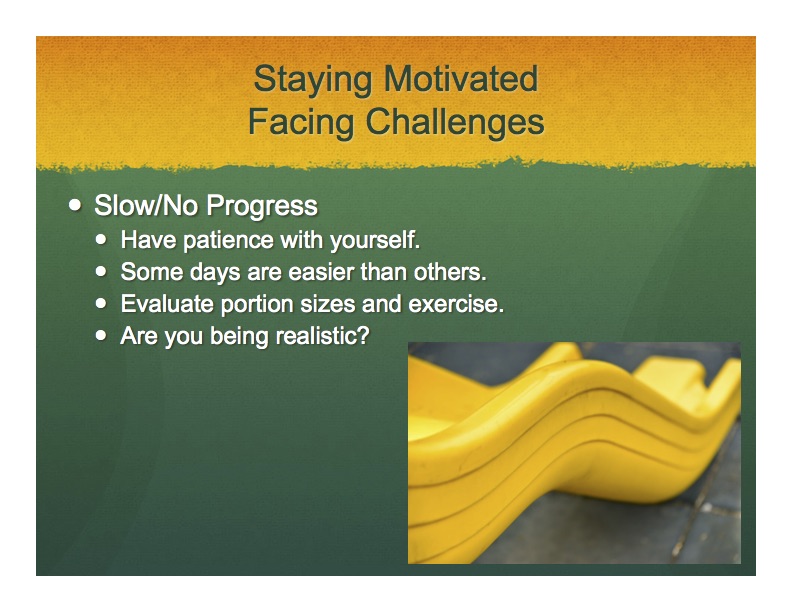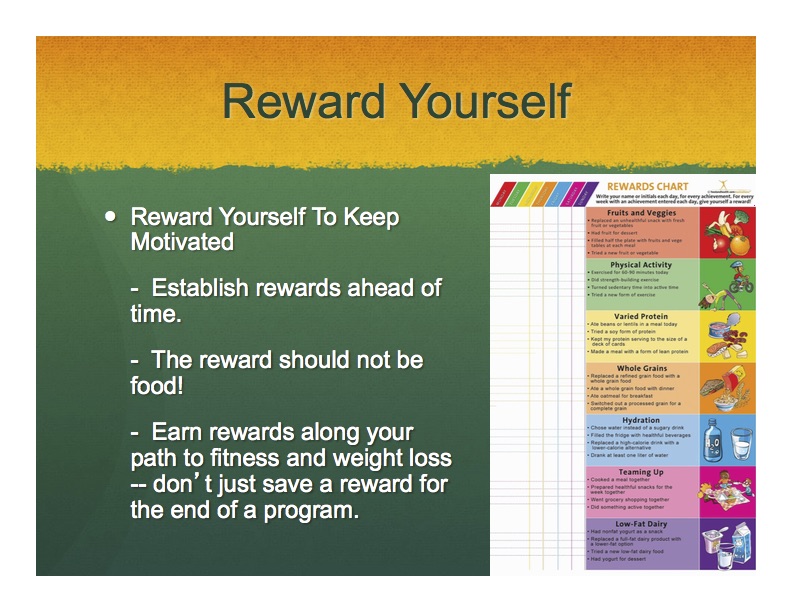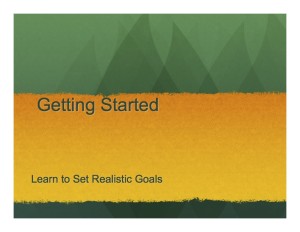 It’s Nutrition Month, which makes it a perfect time to communicate the key nutrition education messages that you’ve been dying to address. Whether you’re psyched to finally be able to discuss the role of saturated fats in heart health, excited to explain the connection between added sugars and obesity, or anything and everything in between, your time has finally come. But how can you ensure that your audience is engaged in what you’re trying to communicate? Well, that’s where Nutrition Month displays come in. Follow these simple steps and you will have put together a colorful, engaging, and informative display that actually reaches the audience you’re trying to address.
It’s Nutrition Month, which makes it a perfect time to communicate the key nutrition education messages that you’ve been dying to address. Whether you’re psyched to finally be able to discuss the role of saturated fats in heart health, excited to explain the connection between added sugars and obesity, or anything and everything in between, your time has finally come. But how can you ensure that your audience is engaged in what you’re trying to communicate? Well, that’s where Nutrition Month displays come in. Follow these simple steps and you will have put together a colorful, engaging, and informative display that actually reaches the audience you’re trying to address.
Part One: Location, Location, Location
You want to make sure that your display is in an area that both draws high traffic and promotes lingering. Though the elevator might be full of people at all hours (and they certainly are a captive audience), the time limits imposed by its speed in reaching its destination make it an unappealing place for a display. Plus, it might get a little cramped in there. By the same token, the conference room at the end of an untraveled hallway might have plenty of space but be unlikely to draw a crowd. Look instead for places that can draw a crowd and keep them there for a bit. Think the company lobby, a break room, a lunch area, etc. Of course, if you’re setting up your display at a wellness fair or nutrition show, then you’ve already got a great location and part one will be a breeze.
Part Two: The Visuals
Once you’ve got a great location, the next step is drawing people to your display. Visuals will be your “make or break” here. With a colorful, intriguing display, you can pique people’s interest and bring them over to learn more. Once they’re engaged, you can delve further into the information you’re trying to communicate. So, what kind of visuals can you use? Consider any of the following…
 A question on a banner. You want to ask something that your audience wants to know the answer to. Skip a dull title like “saturated fats” and instead ask a question like “What are Saturated Fats Doing to YOUR Heart?” Consider coming at the problem from a unique angle. For example “Is Chocolate a Health Food?” tends to draw a crowd because people genuinely want to know whether the answer is yes. Think about what will prompt your participants to… well… participate.
A question on a banner. You want to ask something that your audience wants to know the answer to. Skip a dull title like “saturated fats” and instead ask a question like “What are Saturated Fats Doing to YOUR Heart?” Consider coming at the problem from a unique angle. For example “Is Chocolate a Health Food?” tends to draw a crowd because people genuinely want to know whether the answer is yes. Think about what will prompt your participants to… well… participate.- A poster or two. A pop of color in an unexpected place really draws the eye. Posters offer a great way to communicate the absolute key messages that you want to get across, and do so by addressing several different learning styles. You can browse the amazing selection of posters at the Nutrition Education Store, or craft your own at home. Consider including a chart or graph, a few key points about your topic, and an illustration or two. Craft stores offer scrap booking supplies or you can make and print a poster at a print shop.
- A gift or prize. Do you have something that your participants want? Whether their visit to your display enters them into a raffle for an extra vacation day or you just happened to put a bowl of awesome wristbands out in a highly visible area, if you have something they want, your audience will come to you. A selection of tasty samples for a nutritious cooking demo or quick lunch idea has been known to draw a crowd. They may come for the prize, but then they’ll usually stay for your information.
Of course, you aren’t limited to one or two “hooks” to draw your audience. It could be effective to combine a few of the ideas above. After all, you want your display to appeal to a wide range of people so that everyone will stop by at some point.
Here are popular topics right now:
- Portion control
- Guide to food labels
- Diabetes awareness
- Gardening vegetables
- Supermarket tours
- Healthier cooking with colors
- Energy drink over-consumption
- Healthy 123 – how to make healthier choices for people who are time and budget strapped and making all the wrong choices
- Moving more
- Fad diet 101
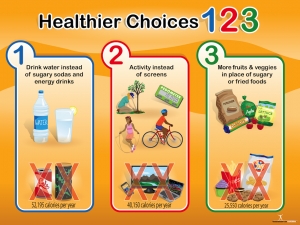
Cheryl Bachinski, a school nurse, is planning a health fair and she needs a banner to help people who are constrained by time and money to make better choices for their families who are struggling with their weight. She says they drink too many sweetened sodas, eat too many cupcakes and chips, and they never exercise. The Healthier Choices 123 Banner was created for her. Check it out and you can buy it on sale or use the display idea for your own.
Part Three: Follow Up
You don’t want to oversimplify and limit yourself to communicating solely through the eye-popping, interest-grabbing visuals. Once people are drawn in by part two, often they will want to know more detail about the subjects you’re addressing. That’s where handouts, recipes, and scientific studies come in. If you’re offering samples of a nutritious dish, for example, it would be wise to have copies of the recipe on hand so that anyone who is interested can make the food themselves. You might also stock a couple handouts about the health benefits of the foods that the recipe features. By the same token, if your visual is a banner asking people whether or not they are eating too much salt, you might want to have some handouts about salt consumption and a few peer-reviewed studies for people to read if they drop by your booth. It’s best if you have lots of copies of whatever you’re disseminating. That way people can review the information multiple times and use your resources as a reference long after the display is dismantled.
 There are lots of other things that you can do to make a great Nutrition Month display. You can coordinate activities, bring in a guest speaker, play games, etc. The possibilities really are endless, but the steps above are a good place to start. Of course, you don’t have to reinvent the wheel — there are tons of display kits that are ready-to-go in the Nutrition Education Store. After all, we gathered this knowledge about how to make an engaging display. Why wouldn’t we apply it right away in order to offer you all the tools you need, with none of the effort? There’s no need to burn the midnight oil crafting the perfect poster/handout combination when there are hundreds of options already available in the store. Plus, we happily (and quickly) create custom supplies upon request.
There are lots of other things that you can do to make a great Nutrition Month display. You can coordinate activities, bring in a guest speaker, play games, etc. The possibilities really are endless, but the steps above are a good place to start. Of course, you don’t have to reinvent the wheel — there are tons of display kits that are ready-to-go in the Nutrition Education Store. After all, we gathered this knowledge about how to make an engaging display. Why wouldn’t we apply it right away in order to offer you all the tools you need, with none of the effort? There’s no need to burn the midnight oil crafting the perfect poster/handout combination when there are hundreds of options already available in the store. Plus, we happily (and quickly) create custom supplies upon request.
Some of the most popular display kits have been selling like gangbusters in the leadup to Nutrition Month, so if you’re looking for one of these, check out the salt display kit (pictured on the left), the cooking demonstration display kit, or the health fair kit. There are also fantastic a la carte items available, things like a poster easel or a vinyl banner. Remember, if you don’t see something that you want, let us know and we’ll make it for you right away!
So, what displays are you putting together for Nutrition Month? Share your great ideas by tweeting us @foodhealth or writing on our Facebook wall.




